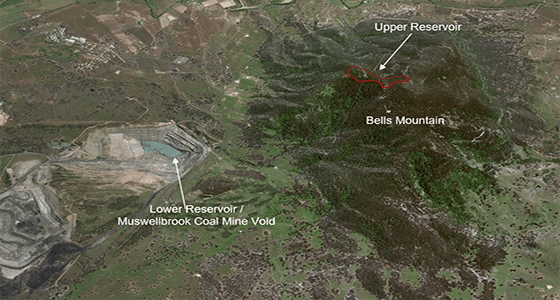Open-cut coal mining by Muswellbrook Coal began on its Upper Hunter site in 1944. Now owned by Idemitsu Australia Resources (IAR), it is next year scheduled to cease operations in its current form. Energy provider AGL and IAR today announced near completion of a preliminary study into the next phase of the pit’s life — as a pumped-hydro facility.
In July 2019, AGL and Idemitsu signed a memorandum of understanding to investigate the engineering feasibility of the Bells Mountain 250 MW, eight-hour duration pumped-hydro energy storage (PHES) project, after the potential for repurposing the pit was identified by Muswellbrook Shire Council.
Around six gigalitres of water are expected to be stored in the void, and excess renewable energy will be used to pump stored water 2,000 meters up Bell’s Mountain to a new 1.9-gigalitre reservoir yet to be constructed. Water will be released to flow through energy-generating turbines as needed.
With only a month to expected completion, the study so far indicates that the AUD450 million ($348.1 million) project has legs.
IAR Chief Commercial Officer, Chris Walsh, said in a statement, that the results are promising.
Markus Brokhof, Chief Operating Officer at AGL, added, “As we transition to more renewable energy sources, pumped hydro provides a reliable on-demand generation source.” He indicated that AGL views the project as potentially beneficial to both the local community and to Australia’s energy transition.
“Innovative rehabilitation solutions, such as the reuse of mine voids … ensure that sites like Muswellbrook can continue to generate investment and long-term employment,” said Walsh.
The PHES facility is expected to connect to the grid via a nearby 330 kV substation, and Idemitsu plans to reroute water licenses currently applied to coal mining and the running of AGL’s Liddell Power Station, which is scheduled to close in 2023, to fill the void over a period of 18 months.

Image: Idemitsu Australia Resources and AGL
The project is currently mooted for completion in 2027, and both companies today expressed their intention to proceed to a full feasibility study — including targeted geotechnical drilling, detailed design of the project, securing of environmental approvals, and contractor engagement — when the current study is complete.
AGL’s other plans for transforming electricity generation on its Liddell and Bayswater Power Station sites include pilots for waste-to-energy and solar-thermal plants, under its new entity Prime Co.
The splitting of AGL into the energy-generating company, dubbed Prime Co, and a retail provider of energy and other services temporarily named New AGL, was announced last month. It has been viewed by some as a cynical move to separate the responsibilities of coal-plant closure — unattractive to investors — from a cleaner, more investible entity, in advance of a full demerger.
However, after last month’s investor briefing AGL Chief Executive Brett Redman characterized the companies soon-to-be decommissioned coal plants in the Hunter as the site of an emerging “energy hub … where we are starting to show some of the vision about where we can invest in all sorts of energy-based projects that build into the longer-term future.”
He added that the company is moving to “repurpose the grid connections that we have got as well as the land and the other infrastructure”.
What’s in store?
AGL is certainly investing in dispatchable stored energy, although at least one of its planned forays into PHES has recently been shelved: that is, the use of voids at Hillgrove Resources Kanmantoo copper mine in South Australia to construct a 250 MW pumped-hydro facility was terminated in February.
Its other planned energy storage projects, based around fast-response batteries, include a 200 MW grid-scale battery at AGL’s Loy Yang power station in Victoria’s Latrobe Valley, and a 250 MW one-hour-duration battery at the site of its Torrens Island power station in South Australia.
Idemitsu, meanwhile, has coal-mining operations in Queensland and New South Wales which produce a total of around 14 million tonnes of coal per annum, and Walsh says it is investigating additional renewable energy developments and export opportunities via its new subsidiary Idemitsu Renewable Development Australia (IRDA).
In Japan, parent company Idemitsu Kosan, also operates solar, wind and geothermal projects, and commercial fuel-cell-vehicle stations. Walsh says IRDA plans to leverage such global expertise, plus battery storage, to develop renewable power projects across its existing coal sites, and thereby “continue to contribute to regional communities like Muswellbrook”.
Brokhof says that the feasibility study into Bells Mountain, is part of AGL’s “commitment to deliver a mix of technologies to the energy system and aligns with our Climate statement and target of net-zero emissions by 2020”.
This content is protected by copyright and may not be reused. If you want to cooperate with us and would like to reuse some of our content, please contact: editors@pv-magazine.com.




I make 1.9 gigalitres and 2000 metres to be around 10 GWh (ignoring losses), but 250MW * 8 hours is 2 GWh.
Also, ballpark $400,000,000/2,000,000 kWh is around $200/kWh, compared to around $130/kWh for raw lithium-based batteries (admittedly ignoring all infrastructure and power converters etc). I was expecting pumped storage to be more convincingly cheaper than batteries. Have I miss-calculated somewhere?